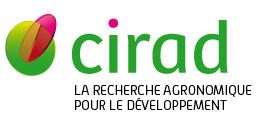Accuracy of genomic selection in a rice synthetic population developed for recurrent selection breeding
Grenier C., Cao T.V., Ospina Y., Quintero C., ChÃĒtel M., TohmÃĐ J., Courtois B., Ahmadi N.. 2015. PloS One, 10 (8) : 25 p..
Genomic selection (GS) is a promising strategy for enhancing genetic gain. We investigated the accuracy of genomic estimated breeding values (GEBV) in four inter-related synthetic populations that underwent several cycles of recurrent selection in an upland rice-breeding program. A total of 343 S2:4 lines extracted from those populations were phenotyped for flowering time, plant height, grain yield and panicle weight, and genotyped with an average density of one marker per 44.8 kb. The relative effect of the linkage disequilibrium (LD) and minor allele frequency (MAF) thresholds for selecting markers, the relative size of the training population (TP) and of the validation population (VP), the selected trait and the genomic prediction models (frequentist and Bayesian) on the accuracy of GEBVs was investigated in 540 cross validation experiments with 100 replicates. The effect of kinship between the training and validation populations was tested in an additional set of 840 cross validation experiments with a single genomic prediction model. LD was high (average r2 = 0.59 at 25 kb) and decreased slowly, distribution of allele frequencies at individual loci was markedly skewed toward unbalanced frequencies (MAF average value 15.2% and median 9.6%), and differentiation between the four synthetic populations was low (FST =0.06). The accuracy of GEBV across all cross validation experiments ranged from 0.12 to 0.54 with an average of 0.30. Significant differences in accuracy were observed among the different levels of each factor investigated. Phenotypic traits had the biggest effect, and the size of the incidence matrix had the smallest. Significant first degree interaction was observed for GEBV accuracy between traits and all the other factors studied, and between prediction models and LD, MAF and composition of the TP. The potential of GS to accelerate genetic gain and breeding options to increase the accuracy of predictions are discussed.
Mots-clÃĐs : oryza sativa; riz pluvial; amÃĐlioration des plantes; gÃĐnÃĐtique des populations; gÃĐnie gÃĐnÃĐtique; sÃĐlection rÃĐcurrente; amÃĐrique latine; caraÃŊbes
Documents associÃĐs
Article (a-revue à facteur d'impact)
Agents Cirad, auteurs de cette publication :
- Cao-Hamadou Tuong-Vi — Bios / UMR AGAP
- Grenier CÃĐcile — Bios / UMR AGAP
